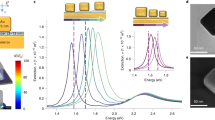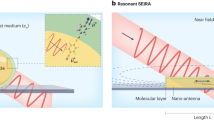Abstract
Enhanced optical absorption of molecules in the vicinity of metallic nanostructures is key to a number of surface-enhanced spectroscopies and of great general interest to the fields of plasmonics and nano-optics. However, experimental access to this absorbance has long proven elusive. Here, we present direct measurements of the surface absorbance of dye molecules adsorbed onto silver nanospheres and, crucially, at sub-monolayer concentrations where dye–dye interactions become negligible. With a large detuning from the plasmon resonance, distinct shifts and broadening of the molecular resonances reveal the intrinsic properties of the dye in contact with the metal colloid, in contrast to the often studied strong-coupling regime where the optical properties of the dye molecules cannot be isolated. The observation of these shifts together with the ability to routinely measure them has broad implications in the interpretation of experiments involving resonant molecules on metallic surfaces, such as surface-enhanced spectroscopies and many aspects of molecular plasmonics.
This is a preview of subscription content, access via your institution
Access options
Subscribe to this journal
Receive 12 print issues and online access
$209.00 per year
only $17.42 per issue
Buy this article
- Purchase on Springer Link
- Instant access to full article PDF
Prices may be subject to local taxes which are calculated during checkout



Similar content being viewed by others
References
Grzelczak, M., Perez-Juste, J., Mulvaney, P. & Liz-Marzán, L. M. Shape control in gold nanoparticle synthesis. Chem. Soc. Rev. 37, 1783–1791 (2008).
Schuller, J. A. et al. Plasmonics for extreme light concentration and manipulation. Nature Mater. 9, 193–204 (2010).
Hess, O. et al. Active nanoplasmonic metamaterials. Nature Mater. 11, 573–584 (2012).
Kühn, S., Håkanson, U., Rogobete, L. & Sandoghdar, V. Enhancement of single-molecule fluorescence using a gold nanoparticle as an optical nanoantenna. Phys. Rev. Lett. 97, 017402 (2006).
Le Ru, E. C. et al. Mechanisms of spectral profile modification in surface-enhanced fluorescence. J. Phys. Chem. C 111, 16076–16079 (2007).
Le Ru, E. C. & Etchegoin, P. G. Principles of Surface Enhanced Raman Spectroscopy and Related Plasmonic Effects (Elsevier, 2009).
Moskovits, M. Surface-enhanced spectroscopy. Rev. Mod. Phys. 57, 783–826 (1985).
Aroca, R. Surface-Enhanced Vibrational Spectroscopy (Wiley, 2006).
Barhoumi, A., Zhang, D., Tamand, F. & Halas, N. J. Surface-enhanced Raman spectroscopy of DNA. J. Am. Chem. Soc. 130, 5523–5529 (2008).
Le Ru, E. C. et al. A scheme for detecting every single target molecule with surface-enhanced Raman spectroscopy. Nano Lett. 11, 5013–5019 (2011).
Brolo, A. G. Plasmonics for future biosensors. Nature Photon. 6, 709–713 (2012).
Govorov, A. O., Fan, Z., Hernandez, P., Slocik, J. M. & Naik, R. R. Theory of circular dichroism of nanomaterials comprising chiral molecules and nanocrystals: plasmon enhancement, dipole interactions, and dielectric effects. Nano Lett. 10, 1374–1382 (2010).
Xu, S., Shan, J., Shi, W., Liu, L. & Xu, L. Modifying photoisomerization efficiency by metallic nanostructures. Opt. Express 19, 12336–12341 (2011).
Kleinman, S. L., Frontiera, R. R., Henry, A.-I., Dieringer, J. A. & Van Duyne, R. P. Creating, characterizing, and controlling chemistry with SERS hot spots. Phys. Chem. Chem. Phys. 15, 21–36 (2013).
Galloway, C. M., Artur, C., Grand, J. & Le Ru, E. C. Photobleaching of fluorophores on the surface of nanoantennas. J. Phys. Chem. C 118, 28820–28830 (2014).
Linic, S., Christopher, P. & Ingram, D. B. Plasmonic-metal nanostructures for efficient conversion of solar to chemical energy. Nature Mater. 10, 911–921 (2011).
Lozano, G. et al. Plasmonics for solid-state lighting: enhanced excitation and directional emission of highly efficient light sources. Light Sci. Appl. 2, e66 (2013).
Atwater, H. A. & Polman, A. Plasmonics for improved photovoltaic devices. Nature Mater. 9, 205–213 (2010).
Mubeen, S. et al. On the plasmonic photovoltaic. ACS Nano 8, 6066–6073 (2014).
Sheldon, M. T., van de Groep, J., Brown, A. M., Polman, A. & Atwater, H. A. Plasmoelectric potentials in metal nanostructures. Science 346, 828–831 (2014).
Craighead, H. G. & Glass, A. Optical absorption of small metal particles with adsorbed dye coats. Opt. Lett. 6, 248–250 (1981).
Wiederrecht, G. P., Wurtz, G. A. & Hranisavljevic, J. Coherent coupling of molecular excitons to electronic polarizations of noble metal nanoparticles. Nano Lett. 4, 2121–2125 (2004).
Haes, A. J., Zou, S., Zhao, J., Schatz, G. C. & Van Duyne, R. P. Localized surface plasmon resonance spectroscopy near molecular resonances. J. Am. Chem. Soc. 128, 10905–10914 (2006).
Zhao, J. et al. Interaction of plasmon and molecular resonances for Rhodamine 6G adsorbed on silver nanoparticles. J. Am. Chem. Soc. 129, 7647–7656 (2007).
Fofang, N. T. et al. Plexcitonic nanoparticles: plasmon–exciton coupling in nanoshell–J-aggregate complexes. Nano Lett. 8, 3481–3487 (2008).
Ni, W. et al. Effects of dyes, gold nanocrystals, pH, and metal ions on plasmonic and molecular resonance coupling. J. Am. Chem. Soc. 132, 4806–4814 (2010).
Ni, W., Ambjörnsson, T., Apell, S. P., Chen, H. & Wang, J. Observing plasmonic–molecular resonance coupling on single gold nanorods. Nano Lett. 10, 77–84 (2010).
Davis, T. J., Gómez, D. E. & Vernon, K. C. Interaction of molecules with localized surface plasmons in metallic nanoparticles. Phys. Rev. B 81, 045432 (2010).
Valmorra, F. et al. Strong coupling between surface plasmon polariton and laser dye Rhodamine 800. Appl. Phys. Lett. 99, 051110 (2011).
Chen, H., Shao, L., Woo, K. C., Wang, J. & Lin, H.-Q. Plasmonic–molecular resonance coupling: plasmonic splitting versus energy transfer. J. Phys. Chem. C 116, 14088–14095 (2012).
Zengin, G. et al. Approaching the strong coupling limit in single plasmonic nanorods interacting with J-aggregates. Sci. Rep. 3, 3074 (2013).
Fang, Y., Blinn, K., Li, X., Weng, G. & Liu, M. Strong coupling between Rhodamine 6G and localized surface plasmon resonance of immobile Ag nanoclusters fabricated by direct current sputtering. Appl. Phys. Lett. 102, 143112 (2013).
Schlather, A. E., Large, N., Urban, A. S., Nordlander, P. & Halas, N. J. Near-field mediated plexcitonic coupling and giant Rabi splitting in individual metallic dimers. Nano Lett. 13, 3281–3286 (2013).
Faucheaux, J. A., Fu, J. & Jain, P. K. Unified theoretical framework for realizing diverse regimes of strong coupling between plasmons and electronic transitions. J. Phys. Chem. C 118, 2710–2717 (2014).
Antosiewicz, T. J., Apell, S. P. & Shegai, T. Plasmon–exciton interactions in a core–shell geometry: from enhanced absorption to strong coupling. ACS Photon. 1, 454–463 (2014).
Cacciola, A., Di Stefano, O., Stassi, R., Saija, R. & Savasta, S. Ultrastrong coupling of plasmons and excitons in a nanoshell. ACS Nano 8, 11483–11492 (2014).
Kasha, M. Energy transfer mechanisms and the molecular exciton model for molecular aggregates. Radiat. Res. 20, 55–70 (1963).
Nelson, N. B. & Prézelin, B. B. Calibration of an integrating sphere for determining the absorption coefficient of scattering suspensions. Appl. Opt. 32, 6710–6717 (1993).
Babin, M. & Stramski, D. Light absorption by aquatic particles in the near-IR spectral region. Limnol. Oceanogr. 47, 911–915 (2002).
Gaigalas, A. K., He, H.-J. & Wang, L. Measurement of absorption and scattering with an integrating sphere detector: application to microalgae. J. Res. Natl Inst. Stand. Technol. 114, 69–81 (2009).
Le Ru, E. C. et al. Experimental demonstration of surface selection rules for SERS on flat metallic surfaces. Chem. Commun. 47, 3903–3905 (2011).
Dignam, M. J. & Moskovits, M. Optical properties of sub-monolayer molecular films. J. Chem. Soc. Faraday Trans. II 69, 56–64 (1973).
Angeloni, L., Smulevich, G. & Marzocchi, M. Resonance Raman spectrum of Crystal Violet. J. Raman Spectrosc. 8, 305–310 (1979).
Morton, S. M. & Jensen, L. A discrete interaction model/quantum mechanical method for describing response properties of molecules adsorbed on metal nanoparticles. J. Chem. Phys. 133, 074103 (2010).
Forker, R., Gruenewald, M. & Fritz, T. Optical differential reflectance spectroscopy on thin molecular films. Annu. Rep. Prog. Chem. Sect. C Phys. Chem. 108, 34–68 (2012).
Dietze, D. R. & Mathies, R. A. Molecular orientation and optical properties of 3,3′-diethylthiatricarbocyanine iodide adsorbed to gold surfaces: consequences for surface-enhanced resonance Raman spectroscopy. J. Phys. Chem. C 119, 9980–9987 (2015).
Le Ru, E. C. & Etchegoin, P. G. Quantifying SERS enhancements. MRS Bull. 38, 631–640 (2013).
Moskovits, M. Persistent misconceptions regarding SERS. Phys. Chem. Chem. Phys. 15, 5301–5311 (2013).
Darby, B. L. & Le Ru, E. C. Competition between molecular adsorption and diffusion: dramatic consequences for SERS in colloidal solutions. J. Am. Chem. Soc. 136, 10965–10973 (2014).
Le Ru, E. C. & Etchegoin, P. G. SERS and plasmonics codes (SPlaC); http://www.vuw.ac.nz/raman/book/codes.aspx
Acknowledgements
E.C.L.R. acknowledges the Royal Society of New Zealand (RSNZ) for support via a Rutherford Discovery Fellowship. The authors thank A. Edgar, P. Northcote and M. Lein from Victoria University of Wellington for discussions.
Author information
Authors and Affiliations
Contributions
B.L.D. and E.C.L.R. designed the original ideas presented in this work and built the experimental set-up with A.E.P. B.L.D. carried out most of the experiments. M.M. optimized various aspects of the experimental set-up, carried out extensive calibration, and performed the DFT calculations. B.A., B.L.D. and E.C.L.R. developed and performed the electromagnetic theory and calculations. The manuscript was jointly written by B.L.D., B.A. and E.C.L.R. All authors discussed the results and the manuscript.
Corresponding author
Ethics declarations
Competing interests
The authors declare no competing financial interests.
Supplementary information
Supplementary information
Supplementary information (PDF 3205 kb)
Rights and permissions
About this article
Cite this article
Darby, B., Auguié, B., Meyer, M. et al. Modified optical absorption of molecules on metallic nanoparticles at sub-monolayer coverage. Nature Photon 10, 40–45 (2016). https://doi.org/10.1038/nphoton.2015.205
Received:
Accepted:
Published:
Issue Date:
DOI: https://doi.org/10.1038/nphoton.2015.205
This article is cited by
-
Exploring visible light enhancement for sensing: an azo-dye decorated gold nanoantenna monitored with a smartphone app
Analytical and Bioanalytical Chemistry (2023)
-
Energy-resolved plasmonic chemistry in individual nanoreactors
Nature Nanotechnology (2021)
-
Bandgap control in two-dimensional semiconductors via coherent doping of plasmonic hot electrons
Nature Communications (2021)
-
Surface Enhanced Raman Scattering from Single-Walled Carbon Nanotube Decorated on Ag Nanowires
Plasmonics (2021)
-
Surface Enhanced Visible Absorption of Dye Molecules in the Near-Field of Gold Nanoparticles
Scientific Reports (2020)



